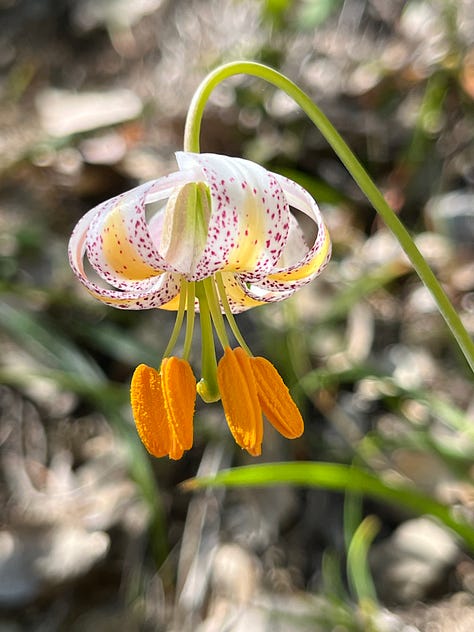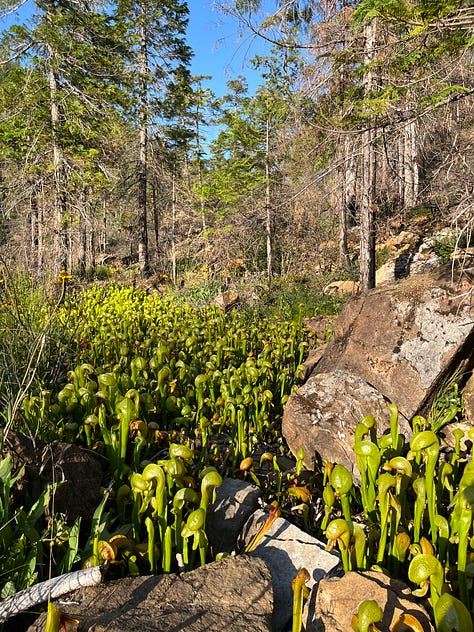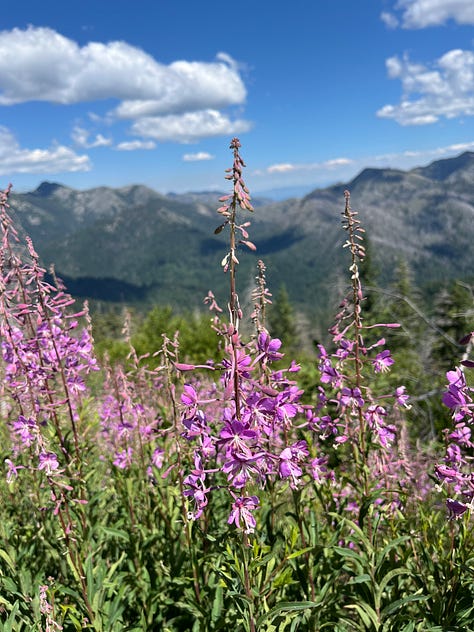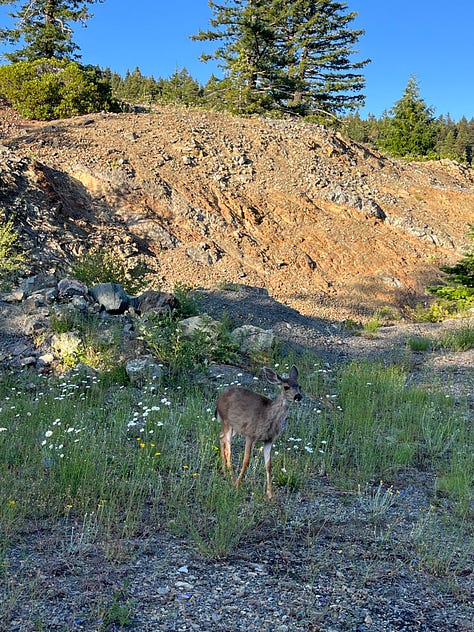Somewhere in the coast range, there’s an elevator ascending up to the clouds. A backwards flowing waterfall, one that carries you skyward where islands rest suspended on the water, a hidden lake made of floating mist. You’d hardly know the sun was setting on the river valley below, as the marine layer blankets the mountain peaks, setting them against the stark glacial fog, a rapidly rising spring whose banks quickly flood us in. The ridge darkens, not allowing us to see the tracks of bear, fox, lion, quail. We try to outrun the mist, but it overtakes us.
This is where you’ll find orchids, rare lilies, carnivorous cobra lily fens, rare serpentine endemics, post-fire ecologies appearing as fields of fireweed and yerba santa. Ancient fir, Port-Orford-cedar and white pine drinking up the ocean drip, soaking in its hazy shroud. A world apart from the dry foothills, human made droughts and climate chaos, yet one that readily adapts and will most certainly outlast empire. The plants remain ever resilient. All you have to do is look up (or down, depending).
I lie there, I lie there,
I lie where I lay
Floating in the shallow water.
It floats there, it floats there,
The mist above the water.
–Ursula K Le Guin, Always Coming Home



Our first time visiting the coast ranges was punctuated by many firsts, plants we’ve waited our whole lives to meet. We always stop for darlingtonia seeps, the cobra lily a sentinel for water’s presence on the dry slopes. The first few times we rode past these stands, the light was harsh and glaring. We didn’t even notice the delicate lady’s slipper orchids dancing above them, tucked along the azalea bushes. Fresh as can be compared to their crispy siblings a few thousand feet below. Their tropical fruit scent so deeply intoxicating, I wanted to curl up and sleep right next to them.
We were lucky to experience this lush ridge after driving around all day, roadside botanizing while scouting for a campsite. Earlier we’d chosen a more exposed site closer to a busy hiking area, and were harassed by two young deer kin and even younger fawn, who, more fearless than I’ve ever seen, insisted on licking the dust off our trailer, almost absconding with our snacks (and our wrench), and who eventually put us in our place by running us clear out and onto a ridge so beautiful, they must have been messengers. Message received!



Turns out it pays to be picky because we stumbled right into another lifer moment when the phantom orchid led us to final camp. Cephalanthera or phantom orchid is a stunning mycohet that produces no chlorophyll and is almost fully stark white, save for a tiny orange lip. They derive nutrients from the mycorrhizae of earthfan fungi and surrounding trees in the deep woods. An incredible being who smells like sweet vanilla and who’s been on our bucket list for years. So grateful to be guided by them this trip, to visit them everyday, to listen to them speak of truth and illusion.
Such deep reverence for mycohets like the phantom, ghost pipe, snow plant, coralroot orchid, leafless wintergreen and others for how they show up as liminal beings, straddling realms of plant and fungi. Most botanists call them parasitic, but here at Queer Botany HQ we prefer to call them mutualistic. There’s no proof they don’t provide host plants with benefits, and parasitism implies a colonial framework of scarcity. The idea that resources are limited when in reality, there is truly enough for everyone, is an affront to nature’s abundance. Plant ecologies find ways to adapt to scarcity that transcend constructs imposed by white colonizers. In any event, the presence of these beings is a sure sign of a flourishing woodland ecosystem.



Plants are always here to remind us how we need each other so completely, that we are intricately woven into ecologies of place in ways unseen, unthought, every shared breath hanging in the mist. Each time I return from the land, from a place outside time, feels harder than the last. The immense grief and violence of these crumbling systems are so much to hold and witness. It’s all worthy of our rage and yes, even despair, which understandably can leave us feeling alone and isolated. More colonial myths of separation that only serve empire.
to the voices that belong
to the stream banks and the trees and the open fields.
There are songs and sayings that belong to this place,
By which it speaks for itself and no other.
Wendell Berry, “2007, VI [‘It is hard to have hope’]
Excerpted by Amy E. Robinson, “Listening to the Loved One” in Red Flag Warning
How could we as a species, ever be separate from these beings with whom we co-evolved, with the power to transform us so deeply if we only listen? Plants have taught me so much about endemicity — how to be of a place — to find belonging, a niche, to adapt and specialize, to play to our strengths. Plants are locked tf in. Their soft power and mutual flourishing will outlast all systems that exploit and extract. When we begin to listen to the medicine of place, to carry the seeds and stories back, we learn how to tend, what needs giving back (in case it needs to be said, I would never harvest any of these plants, though I did make several no-pick essences).
Our work as ever is to practice mutual care, most of which goes unseen, below the fog of these digital realms. To tap into the wellsprings of life that are so abundant on this planet, to allow ourselves to be resourced by them and practice offering gratitude in return. Somewhere nearby there’s a tree whose life outstretches your own, the awakening scent of a wild mint patch, the ripest peach of summer, an ancient spring that has traveled miles to meet you, some tender new growth unfurling. Like the stream orchid whose roots follow the river, let the free flowing rage wash over us, wet our feet, soften us enough to feel our hearts break, to help each other hold on.








